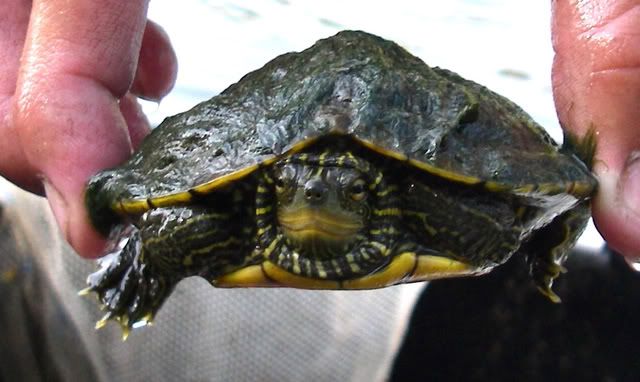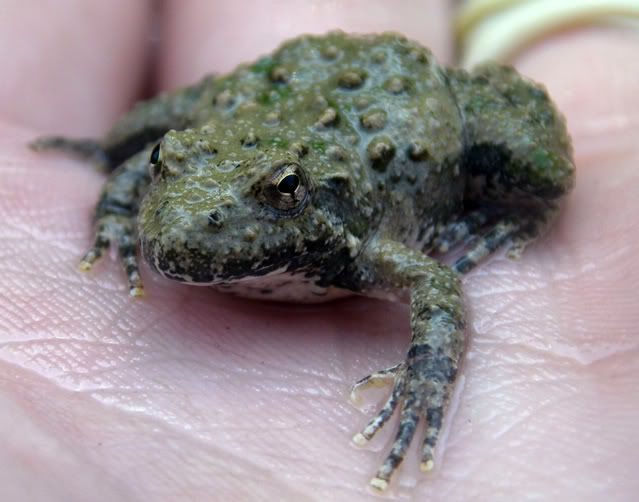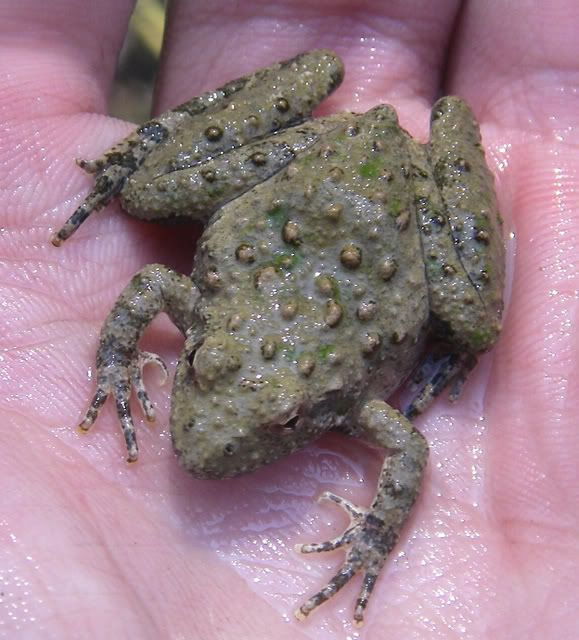My Time with the MBI
#41
 Guest_teleost_*
Guest_teleost_*
Posted 21 January 2008 - 10:53 AM
#42
 Guest_NateTessler13_*
Guest_NateTessler13_*
Posted 23 January 2008 - 12:47 AM
Back to the DuPage (this is the last site I have for the DuPage...oddly enough, I have pictures from a site on September 15th, but no data in my notebook. Maybe Brian can help it out if he wants). After this, we went into Indiana to do the Iroquois River, but that's for next post. Here's this spot, one of the most interesting sites we did on the DuPage River.
Date: September 16, 2007
Location: DuPage River in Channahon, IL. Upstream one mile of US 6.
Water Level: Normal for this time of year. Max depth here was 1.1m.
Water Quality: The water here was clearer and the substrate was cleaner than at any other DuPage River site weve done. There was a greater average depth and there was not as much enrichment. The water was clear enough so that I could use a tree branch to sit still in the current and watch schools of large Striped Shiner swim around the canoe.
Water Temp.: 17.0*C
Substrate: Mostly cobble and sand. Cleaner than at previous sites. Unlike other sites, there were few macrophytes.
Collected:
Common Carp (Cyprinus carpio) lots of very large ones.
Golden Shiner (Notemigonus crysoleucas)
Hornyhead Chub (Nocomis biguttatus)
Central Striped Shiner (Luxilus chrysocephalus chrysocephalus) lots of large ones were found near the log jams and over hanging vegetation.
Spotfin Shiner (Cyprinella spiloptera) only a few
Sand Shiner (Notropis stramineus stramineus) also only a few were found here
Bluntnose Minnow (Pimephales notatus) lots of these here. Bluntnose Minnow, C. Striped Shiner, and Hornyhead Chub made up the bulk of the findings here.
Golden Redhorse (Moxostoma erythrurum) this is the first site wed seen Golden Redhorse at. We didnt see any Shorthead Redhorse though. We only found a few, and they were pretty large.
White Sucker (Catostomus commersonii commersonii) a few large ones were found here. This wider stretch of the river, without as many nutrient issues as were found on other parts of the river, I wouldnt have expected to see as many large White Suckers as we did here.
Channel Catfish (Ictalurus punctatus)
Blackstripe Topminnow (Fundulus notatus) a few.
Rock Bass (Ambloplites rupestris) lots of big ones were found here, like all the DuPage River sites. This site would have been easy to sight fish for big Rock Bass.
Northern Largemouth Bass (Micropterus salmoides salmoides) only a few were here. This spot was indicative of a big Smallmouth Bass spot on this river. There seems to be quite a few of those kind of spots here.
Northern Smallmouth Bass (Micropterus dolomieu dolmieu) lots of small ones were found here. A few big ones were found around the deeper spots near the log jams. One that was netted was 19.5 long. When I was canoeing around, I saw some logjams where a few nice bass were sitting in ambush waiting for C. Striped Shiners probably.
Green Sunfish (Lepomis cyanellus) only a few, but the ones we did find were pretty large.
Bluegill Sunfish (Lepomis macrochirus macrochirus) lots of smaller ones.
Northern Longear Sunfish (Lepomis megalotis peltastes)
Hybrid Sunfish (Lepomis hybrid)
Northern Logperch (Percina caprodes semifasciata) one large one was found here. This was our Percina species of darter found in this river. A local resident that we talked to gave what could be an explanation for this. (in the notes section).
Johnny Darter (Etheostoma nigrum) only one.
Notes: Electroshocked via a boat here. This site had some different species than at any other site that we sampled. A landowner told us that a dam had been removed only a few years ago in the area, which may have caused for an influx of different species still trying to scratch out a niche in an area that was previously not colonized by a wide variety of species. Also, a watersnake was watching us process the fish. We might have lured him with a Bluntnose Minnow and then captured him
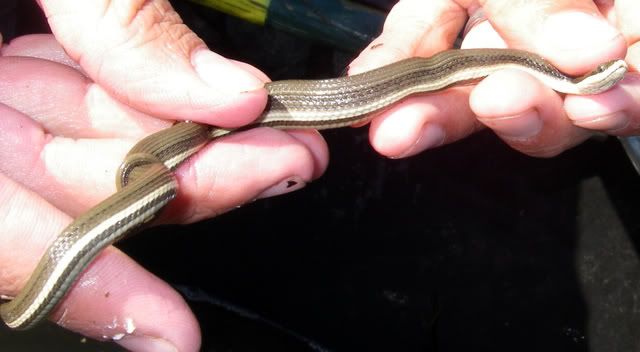
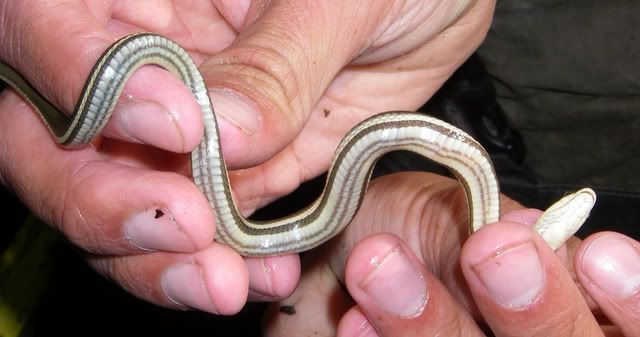
-not sure which kind he is.
#44
 Guest_NateTessler13_*
Guest_NateTessler13_*
Posted 27 January 2008 - 04:45 PM
Date: September 17, 2007
Location: Iroquois River near Rensselaer, IN. 2 miles west of I-65.
Water Level: At or below normal levels for this time of year. The deepest area was 1.3m.
Water Quality: Very turbid. Lots of siltation. The are looked channelized and dredged. The bank was eroded and lots of silt would get added after a rainfall event. Although, it did have a somewhat intact riparian zone.
Water Temp.: 14.6*C
Substrate: Mostly muck with sand mixed in. Lots of silt. A good amount of flooded timber lined the shoreline.
Collected:
Gizzard Shad (Dorosoma cepedianum) a few.
Northern Pike (Esox lucius)

found one that was about 20 long. He was right near the flooded timber along the shoreline.
Common Carp (Cyprinus carpio)
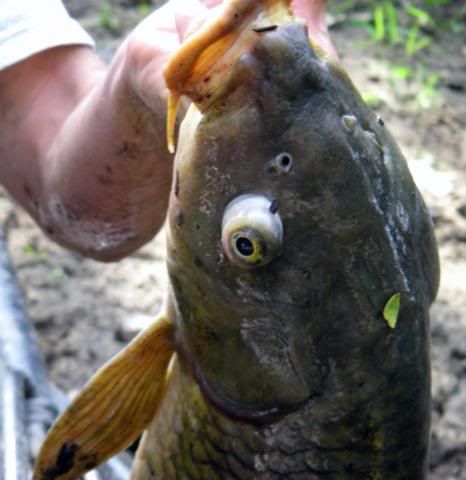
lots of big ones, the one pictured has popeye.
Spotfin Shiner (Cyprinella spiloptera)
Central Striped Shiner (Luxilus chrysocephalus chrysocephalus) lots here, the most abundant cyprinid.
Sand Shiner (Notropis stramineus stramineus) only a few.
Bigmouth Buffalo (Ictiobus cyprinellus)

only got one big one. We found all 3 different kinds of Buffalo fish here. The habitat was really similar, so it was hard to see any preference between the species for habitat.
Black Buffalo (Ictiobus niger)
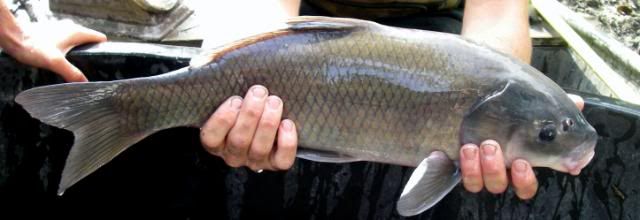
a few large ones were found. It was helpful to get all 3 different kinds, so we could be confident with our IDs of the fish.
Smallmouth Buffalo (Ictiobus bubalus)
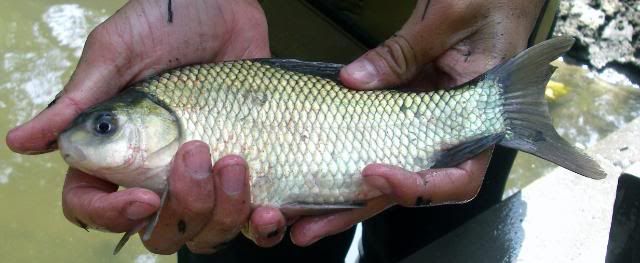
only this one small one was caught.
Central Quillback (Carpiodes cyprinus hinei) a few large ones were here. This place had an abundance of large fish.
Silver Redhorse (Moxostoma anisurum)
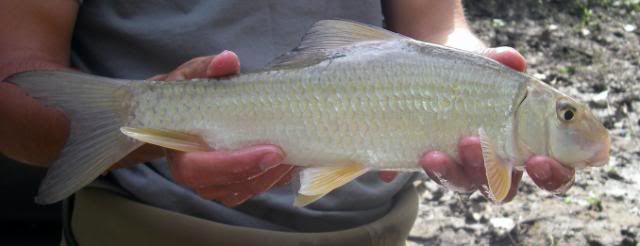
lots of big ones were found here in the main channel of the river. They were larger than any of the other Moxostoma species that we ran into here. They are easy to distinguish by the number of dorsal fin rays and the shape of their mouth.
Golden Redhorse (Moxostoma erythrurum)
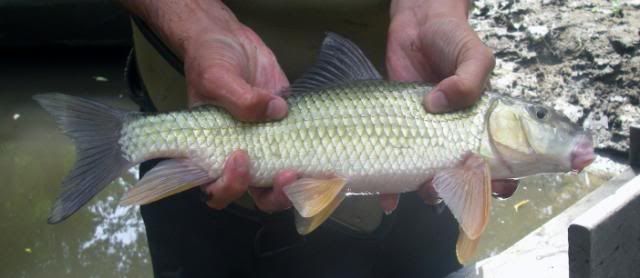
we got large adults of this species here. We were able to compare them quickly with the Silver Redhorse by looking at the mouth on the fish.
Shorthead Redhorse (Moxostoma macrolepidotum)
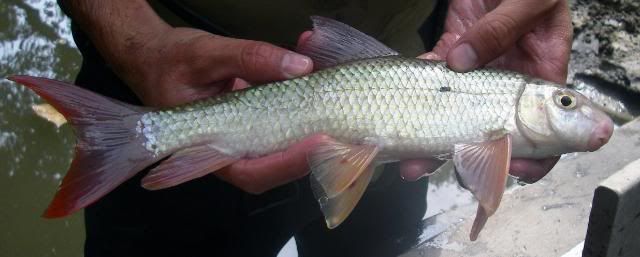
easy to tell from the others by their red tails.
Spotted Sucker (Minytrema melanops)

a few young of year ones. Their identification was of debate because we thought they might be y.o.y. Shorthead Redhorse. We keyed them out as Spotted Sucker because of their incomplete lateral lines.
Channel Catfish (Ictalurus punctatus) a few large ones.
Rock Bass (Ambloplites rupestris) it was almost a welcomed site to not get as many Rock Bass here. With their nine dorsal spines, they give you a good stabbin when you reach in the livewell to get them out.
Black Crappie (Pomoxis nigromaculatus)
Northern Largemouth Bass (Micropterus salmoides salmoides) a few large ones. This area seemed more fit for Largemouth Bass than Smallmouth Bass because of the slower flowing water.
Northern Smallmouth Bass (Micropterus dolomieu dolomieu) a few large ones were here. Nothing close to the numbers that we saw in the DuPage River system.
Green Sunfish (Lepomis cyanellus)
Bluegill Sunfish (Lepomis macrochirus macrochirus)
Northern Longear Sunfish (Lepomis megalotis peltastes)
Walleye (Sander vitreus vitreus)
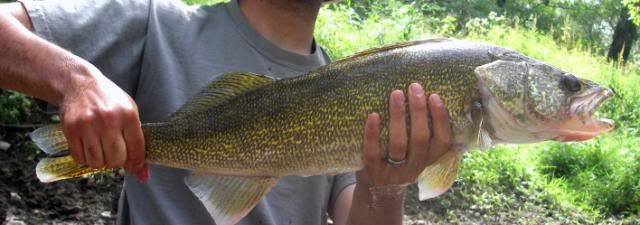
a few large ones were found near the deeper holes with lots of log jams. The one pictured was 25 long and weighed nearly 6lbs.
Notes: Electroshocked via a boat. There was a diverse sucker community here. Lots of really large fish. There was a good amount of diversity among fish here even though it seemed to be a low quality stream (low score on the Qualitative Habitat Analysis sheet). Also found some painted turtles here. I'll follow up with a picture I liked of one of the turtles and then examples of how to ID the different Redhorse species we found here.
#45
 Guest_NateTessler13_*
Guest_NateTessler13_*
Posted 27 January 2008 - 04:55 PM
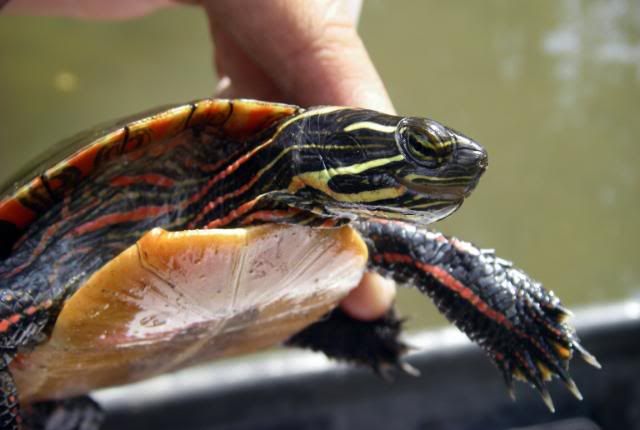
The Silver Redhorse was easy to ID because of the high number of dorsal fin rays (usually around 14).
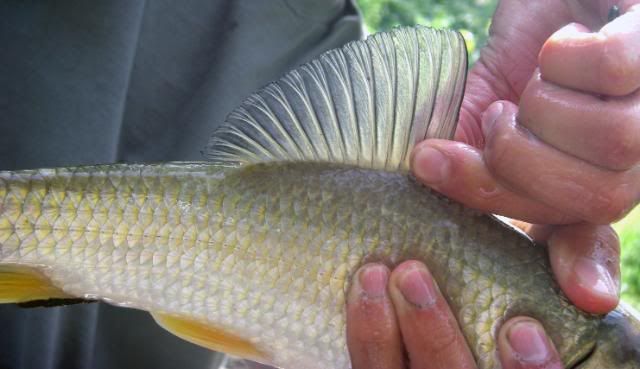
The Silver Redhorse also has a distinctive mouth. When the lips are closed (or near closed) there is a strong upside down "V" shape to the lips.
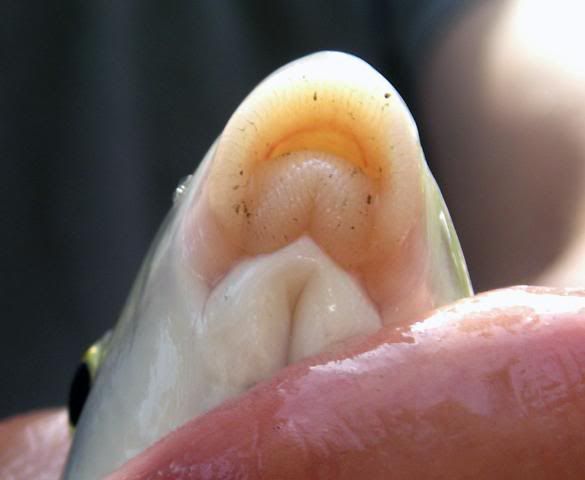
The Golden Redhorse looks similar to the Silver Redhorse, but turning the fish over and looking at its mouth would tell you easily that the fish was a not a Silver.

There are plenty of ways to tell these fish apart, but these were some of the easiest for me.
#46
 Guest_NateTessler13_*
Guest_NateTessler13_*
Posted 28 January 2008 - 01:57 AM
Location: Iroquois River in Iroquois, IL. At US 52.
Water Level: Normal summer levels. A maximum depth of 2.3m near some of the logjams.
Water Quality: Very turbid water. A lot of siltation and soil erosion. Many fallen trees were in the water due to the extensive soil erosion. The constituted some of the only available structure.
Water Temp.: 18.5*C
Substrate: Muck and sand. Heavily silted, lots of fallen trees and logjams.
Collected:
Gizzard Shad (Dorosoma cepedianum)
Common Carp (Cyprinus carpio) lots of really big ones, as can be expected in a stream with these attributes.
Central Striped Shiner (Luxilus chrysocephalus chrysocephalus) only one.
Bluntnose Minnow (Pimephales notatus) just a few.
Bullhead Minnow (Pimephales vigilax) also, just a few. Minnows were hard to capture here, probably due to the deeper water.
Spotfin Shiner (Cyprinella spiloptera)
Bigmouth Buffalo (Ictiobus cyprinellus)
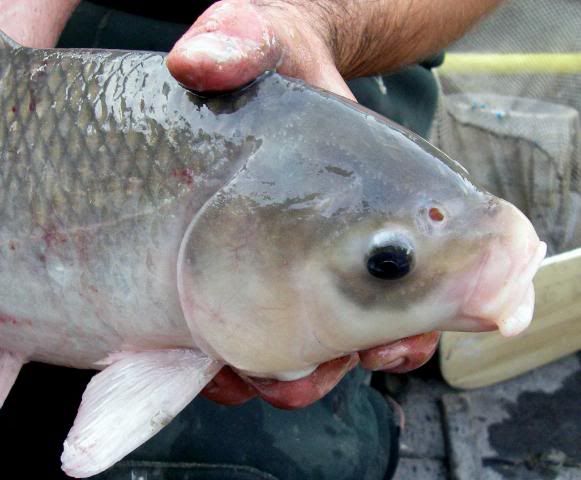
a few large ones, they were definitely more common than the Black Buffalo and Smallmouth Buffalo.
Black Buffalo (Ictiobus niger)
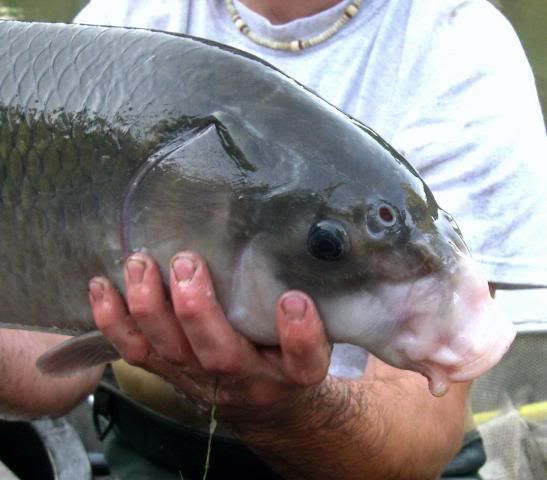
only got one large one.
Smallmouth Buffalo (Ictiobus bubalus)
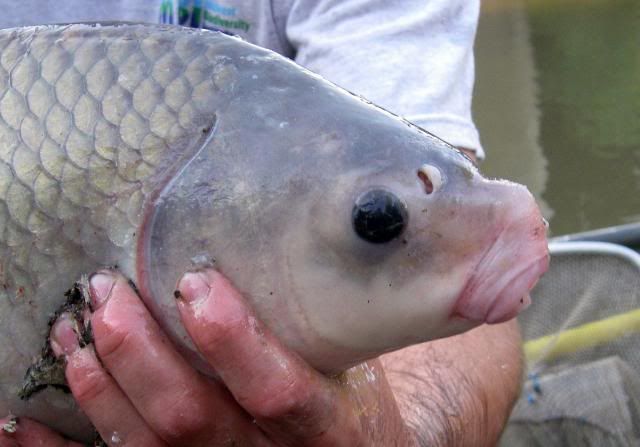
finally saw a large one of this species.
Northern Quillback (Carpiodes cyprinus cyprinus)
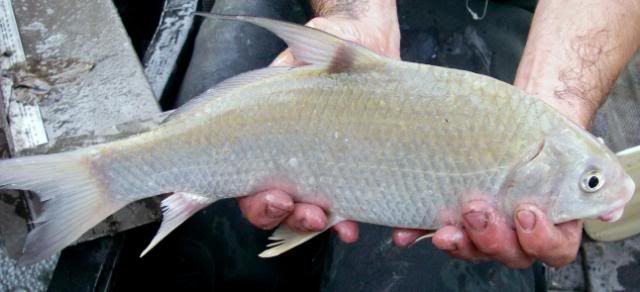
only one big one. Brian was doing a great job of telling me about the differences in the Northern and Central Quillback. He can shine some light on this when he gets around to it.
Central Quillback (Carpiodes cyprinus hinei)
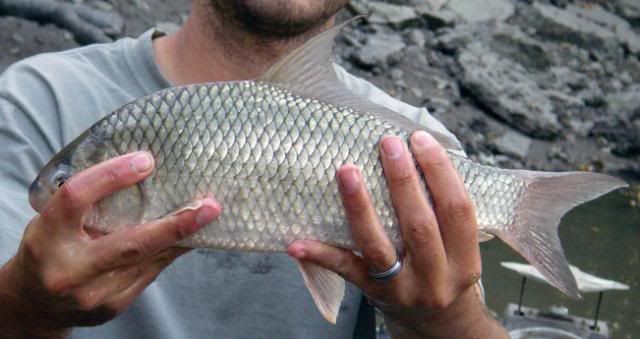
got a few adult sized fish here.
Silver Redhorse (Moxostoma anisurum)
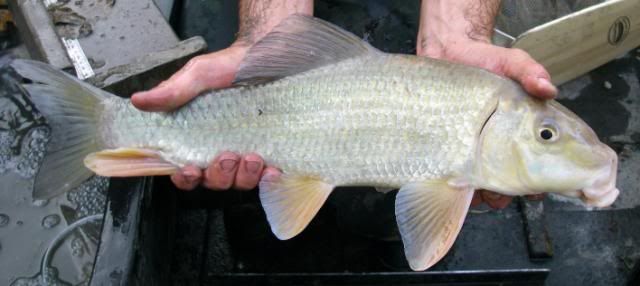
these are a large species of Redhorse. We saw some that were pushing 5lbs.
Golden Redhorse (Moxostoma erythrurum)
Shorthead Redhorse (Moxostoma macrolepidotum)
Spotted Sucker (Minytrema melanops) only y.o.y. ones again.
Channel Catfish (Ictalurus punctatus) a few large ones in the deeper pools.
Yellow Bullhead (Ameiurus natalis) we hadnt seen these in awhile. I was expecting to see a lot more of them at sites on the DuPage.
Brook Silverside (Labidesthes sicculus)
White Crappie (Pomoxis annularis)
Rock Bass (Ambloplites rupestris) only a few here. This really wasnt ideal habitat for these fish.
Northern Largemouth Bass (Micropterus salmoides salmoides)
Northern Smallmouth Bass (Micropterus dolomieu dolomieu) only one. We definitely seemed to be out of ideal Smallmouth Bass habitat here.
Green Sunfish (Lepomis cyanellus)
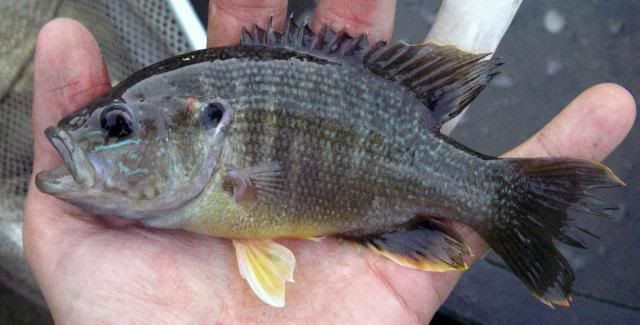
Bluegill Sunfish (Lepomis macrochirus)
Northern Longear Sunfish (Lepomis megalotis peltastes)
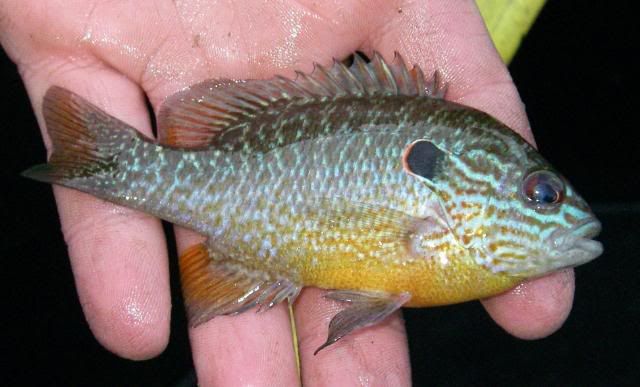
low densities of all Sunfish here.
Walleye (Sander vitreus vitreus)
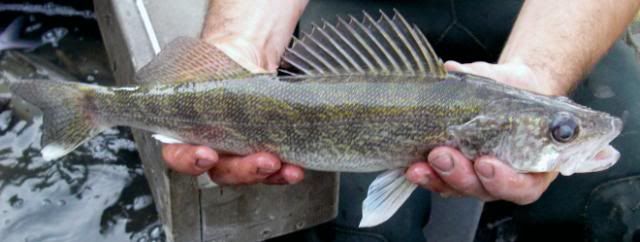
just a few smaller ones.
Blackside Darter (Percina maculata) finally found some of these. I was expecting to see them at a few of the other sites. This site had slow flowing water with lots of flooded timber. Ideal for this and some similar Percina species of darter.
Notes: Electrofished from a boat here (as with the rest of the remaining sites). This site was really similar to the Indiana site. The water took on a heavy silt load here. I actually noticed a mussel walking out of the water on to a log when I was canoeing downstream. I was surprised to find any live mussels in this stretch of the river.
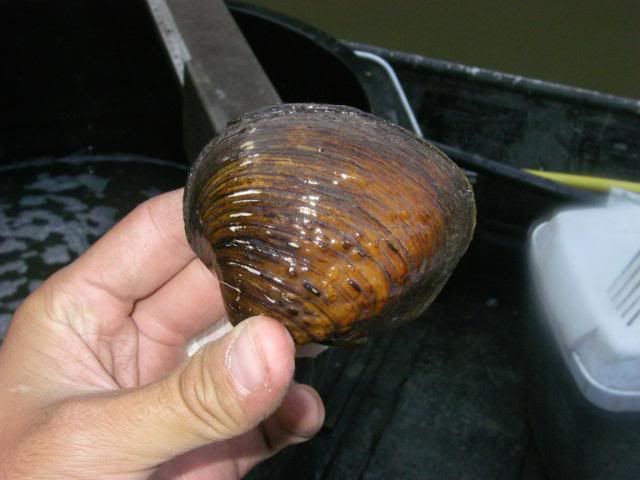
#47
 Guest_farmertodd_*
Guest_farmertodd_*
Posted 28 January 2008 - 10:04 AM
The mussel species is a pimpleback, Quadrula pustulosa. They're very common in big rivers and lakes. One of hosts identified are channel and flathead catfish. It's too bad you didn't run into a really nicely colored specimen with bright green rays. They're a very stunning species.
Todd
#48

Posted 28 January 2008 - 11:40 AM
Keep it up!
Nate, you are doing us all a HUGE service posting these pictures with the data. There's really no way to see all these sucker species like you have without E-fishing. This is phenomenal
Perhaps we can make a web ditty that summarizes the various species for the NANFA website. I'd be glad to help with that.
The mussel species is a pimpleback, Quadrula pustulosa. They're very common in big rivers and lakes. One of hosts identified are channel and flathead catfish. It's too bad you didn't run into a really nicely colored specimen with bright green rays. They're a very stunning species.
Todd
#49
 Guest_NateTessler13_*
Guest_NateTessler13_*
Posted 28 January 2008 - 02:28 PM
Brian, while at the MBI, put together a key to all the different Moxostoma species from pictures that we'd taken. I think I have it somewhere, it'd be really helpful to everyone.Nate, you are doing us all a HUGE service posting these pictures with the data. There's really no way to see all these sucker species like you have without E-fishing. This is phenomenal
Perhaps we can make a web ditty that summarizes the various species for the NANFA website. I'd be glad to help with that.
The mussel species is a pimpleback, Quadrula pustulosa. They're very common in big rivers and lakes. One of hosts identified are channel and flathead catfish. It's too bad you didn't run into a really nicely colored specimen with bright green rays. They're a very stunning species.
Todd
I want to agree with Todd about how great this is for the non-professional... particularly the summary of the identification particulars... lots of times we talk about "oh that's obviously a xxx" but you are telling us "why" it is such and such... that is a real service as it not only tells, it teaches (andeducation may be our highest calling as NANFA whether we are a professional, hobbyist, fish watcher, or aquarium keeper).
Keep it up!
Hope that I can help out the people who it's not so obvious to what species everything is. It's a learning process for us all, I'm still just a student, and this is how I learned. Glad to share it.
#50
 Guest_NateTessler13_*
Guest_NateTessler13_*
Posted 18 February 2008 - 11:46 PM
Date: September 18, 2007
Location: Kankakee River near Wilmington, IL. At the Warner Rd. bridge in the Kankakee River State Park.
Water Level: Slightly above normal levels. One hole was 5m deep. This deep area was right next to the bluff shown in the picture.
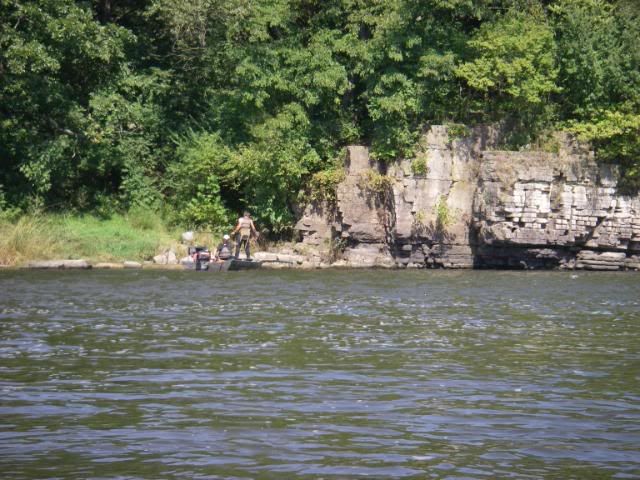
Most of the stretch was 1.5 m deep though. Also a large riffle area was sampled at the beginning of this site.
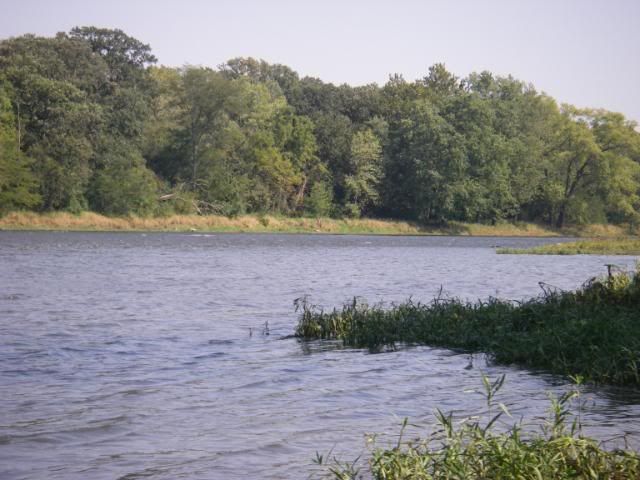
Water Quality: I was surprised at the clarity of the water here. The secchi read all the way down to the bottom of the deepest areas (around 5m). There was barely any siltation here due to the strong flow. The riffle here flowed into a deeper rapids area where the bluff was located. The moving water scoured out the deep hole, and there were plenty of large fish there. There was a very intact riparian zone as well, being that we were in the State Park. D.O. 12.97 mg/L.
Water Temp.: 21.03*C
Substrate: Cobble and gravel with a rich algae growth in the riffles. The substrate had very little siltation. The main channel looked like it was a limestone bedrock bottom with some large boulders strewn in.
Collected:
Longnose Gar (Lepisosteus osseus)

- found a few large adult in the slack water below the riffle and pool that were at the upstream portion of our site. They could be seen slowly moving over the bedrock.
Common Carp (Cyprinus carpio)
Hornyhead Chub (Nocomis biguttatus) a few smaller ones were in the riffle area that we started sampling. We had to abandon ship to sample this large riffle.
Central Striped Shiner (Luxilus chrysocephalus chrysocephalus)
Bluntnose Minnow (Pimephales notatus)
Spotfin Shiner (Cyprinella spiloptera)
Carmine Shiner (Notropis percobromus) a few. Brian and I, being familiar with Rosyface Shiners (N. rubellus), were calling these Rosyface. But, according to distribution, these fall into Carmine Shiner country.
Central Stoneroller (Campostoma anomalum pullum) a few in the algae rich riffle areas.
Northern Quillback (Carpiodes cyprinus cyprinus) one large one. Most of the large sucker species were in the pool and rapids area below the large riffle.
Shorthead Redhorse (Moxostoma macrolepidotum) a few large ones were taken in the pool downstream of the riffle. This area was loaded with fish.
River Redhorse (Moxostoma carinatum)

this was my first time seeing this species of Redhorse. These Redhorse were easily the largest Redhorse species Ive ever seen. They were similar to Shorthead Redhorse in that they both have a red caudal fin. But, when you look at the head size on a River Redhorse, its easy to see that these fish are not Shortheads by any stretch. The fish pictured is an adult male with tubercles on its head.
Silver Redhorse (Moxostoma anisurum)
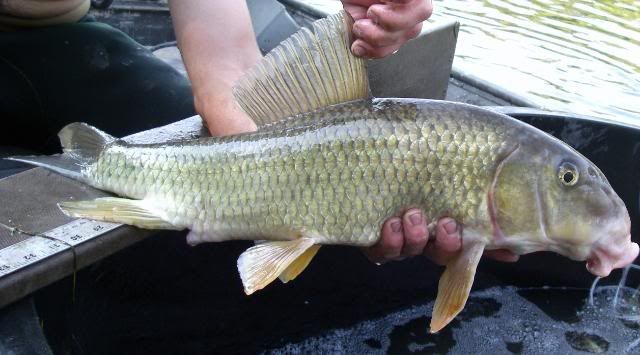
one large one that was blind in one eye. Count those dorsal fin rays, definitely a Silver. These are another very large species of Redhorse. This area of the river was home to lots of large fish.
Black Redhorse (Moxostoma duquesnei)
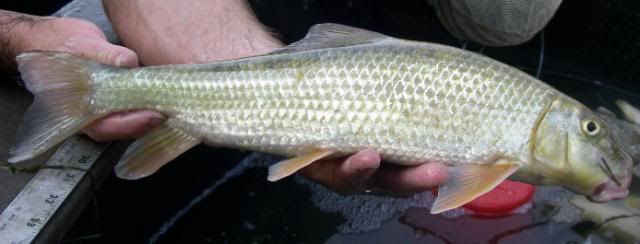
did not see any Golden Redhorse here. Only Black Redhorse. Black Redhorse arent very common in Illinois either. We saw a preference for cleaner substrates being preferred by Black Redhorse when comparing Black Redhorse habitats to Golden Redhorse habitats. When you have an adult Black Redhorse (as is pictured) it is easy to tell them apart from Golden Redhorse. For me, the most telling feature was the body shape. The Black Redhorse has more of a terete body shape. It is longer bodied than a Golden Redhorse. The other way is to simply count the lateral line scales. This fish has 47. When you get above 44 you have yourself a Black Redhorse. (This is barring the fact that the fish has doesnt have Silver Redhorse qualities, this is only helpful for distinguishing between Black and Golden Redhorse). Also, keep in mind, they both have gray/slate colored tails, as opposed to the red tails we see on River Redhorse and Shorthead Redhorse.
Northern Hogsucker (Hypentelium nigricans) a few large ones.
Channel Catfish (Ictalurus punctatus) lots of fish in the 3-5lb. range.
Yellow Bullhead (Ameiurus natalis) a few were found in the slack water along the shoreline after the bluff.
Stonecat (Noturus flavus) got a few in the riffle at the beginning.
Blackstripe Topminnow (Fundulus notatus)
Brook Silverside (Labidesthes sicculus) only one small one.
Rock Bass (Ambloplites rupestris) these were very abundant in and around the large boulders that were in the pool that was below the riffle.
Northern Smallmouth Bass (Micropterus dolomieu dolomieu) lots of large ones were found here in the pool. This would have been a great place to fish.
Northern Largemouth Bass (Micropterus salmoides salmoides) only one little one.
Bluegill Sunfish (Lepomis macrochirus macrochirus)
Green Sunfish (Lepomis cyanellus) these fish and Northern Longear Sunfish made up the bulk of our catch. We had to stop in the middle of the sample and process fish because we had so many of each of these fish in our livewell. Probably a couple hundred put together.
Northern Longear Sunfish (Lepomis megalotis peltastes) although we were close to areas where Northern Longear and Central Longear overlap, we didnt see any odd ones here. At another site on the Kankakee, things got weird.
Hybrid Sunfish (Lepomis hybrid)
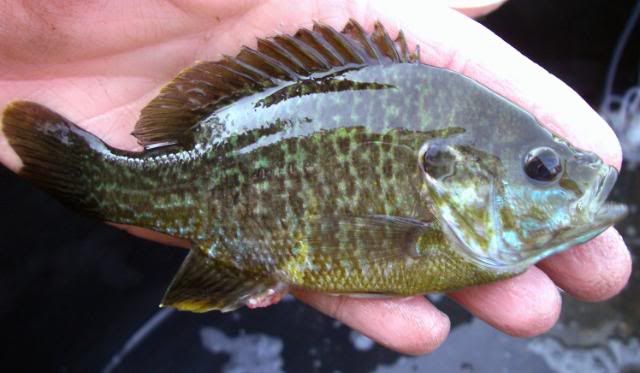
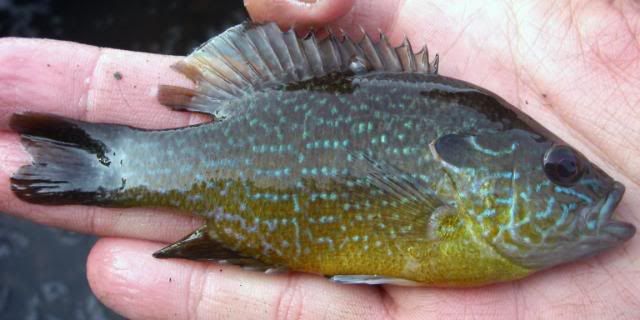
- we called the 1st one a Bluegill x Green Sunfish. The 2nd one we called a N. Longear Sunfish x Green Sunfish (that's a tough one though, in my opinion).
Walleye (Sander vitreus vitreus) got one nice sized one here. We were told by a local fisherman that the Department of Natural Resources stocks them here in this stretch of the river.
Northern Logperch (Percina caprodes semifasciata) finally got some darter diversity here. This was in large part due to being able to sample a large riffle area.
Blackside Darter (Percina maculata) these were found near the shoreline, out of the current, by some vegetation.
Slenderhead Darter (Percina phoxocephala) these are pretty abundant in this river. They seem to be occurring on the edge of a riffle where it meets aquatic vegetation. Mid river islands were teeming with these.
Banded Darter (Etheostoma zonale)
Rainbow Darter (Etheostoma caeruleum) found alongside the Banded Darters in the riffle.
Johnny Darter (Etheostoma nigrum) outside of the current, near the Blackside Darter.
Freshwater Drum (Aplodinotus grunniens)
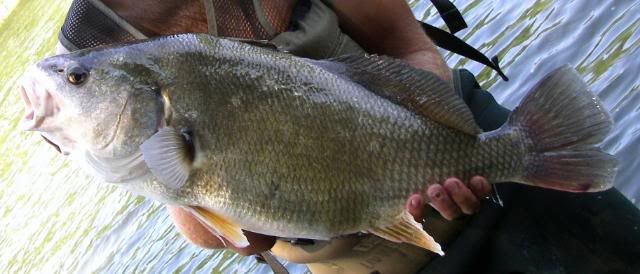
these were found in the deepest areas of the sample. When this large one was shocked, I could see it near the bottom almost 15 down. That one was a struggle to bring up too, think it weighed over 10lbs.
Notes: This spot had a lot of current for being such a large river. There was lots of suitable habitat for a variety of fish, and it scored really well on Qualitative Habitat Analysis evaluations done on the site. We also found this turtle. I think its a River Cooter.
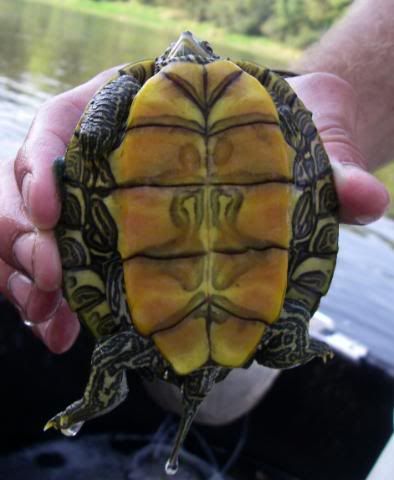
#52
 Guest_NateTessler13_*
Guest_NateTessler13_*
Posted 19 February 2008 - 10:39 AM
But looking ahead, I've got a spot on the Mazon River that was wadeable that you could catch River Redhorse with a seine without a problem.
#56
 Guest_NateTessler13_*
Guest_NateTessler13_*
Posted 19 February 2008 - 11:56 AM
Date: September 19, 2007
Location: Mazon River near Morris, IL. Upstream of the Pine Bluff Rd. bridge.
Water Level: Normal summer pool levels. The area sampled ranged in depth from shallow riffles to 1.0 m deep pools. There was a definite riffle; pool; riffle pattern to this area.
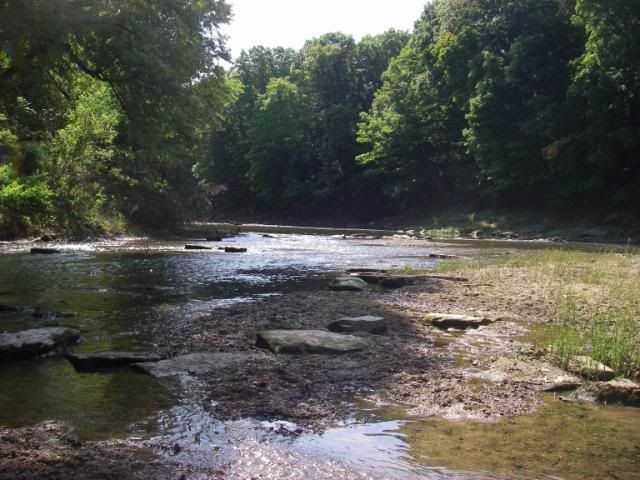
Water Quality: Pretty clear with very little siltation. It was also obvious that the water quality was high and siltation was low because there was an incredible abundance of live mussels. Parts of the riffles seemed like equal parts rocks and equal parts mussels. Well developed riparian zone as well.
Water Temp.: 24*C
Substrate: Clean cobble and sand. The pools had bedrock bottoms. There was a small amount of vegetation alongside the upper and lower ends of the pools.
Collected:
Longnose Gar (Lepisosteus osseus) as we were boating upstream we could see large adults swimming slowly near the surface. At one point I got out of the boat and swam with a waterproof camera and tried to get underwater pictures of the gar. All I got was shades of gray on the camera.
Gizzard Shad (Dorosoma cepedianum) finding large Gar and Gizzard Shad here was surprising due to the clarity of the water and small size of the stream. There were parts of the stream that were plenty deep, but our sample site was overall very shallow (as you can see from the picture).
Hornyhead Chub (Nocomis biguttatus) only one, although this habitat looked ideal for a good population of these and other minnow species.
Central Striped Shiner (Luxilus chrysocephalus chrysocephalus) lots, these were abundant in every pool.
Bluntnose Minnow (Pimephales notatus) very abundant
Redfin Shiner (Lythrurus umbratilis) only one.
Spotfin Shiner (Cyprinella spiloptera) also very abundant.
Emerald Shiner (Notropis atherinoides) a few were just below a riffle. We could see them in the water and before we caught them, we were almost sure theyd be Carmine Shiners, due to the habitat and general body shape.
Sand Shiner (Notropis stramineus stramineus) this was definitely ideal habitat for Sand Shiners. There were plenty of areas that had clean sand with good flow. Brian and I were actually looking out for Sand Darters here.
Largescale Stoneroller (Campostoma oligolepis)

these were very abundant here. Every riffle had lots of algae growth on its rocks. Wherever there were algae covered rocks, there were Largescale Stonerollers. They definitely had a larger scale size than the common Central Stoneroller.
Central Quillback (Carpiodes cyprinus hinei)

- The one pictured has whorled scales. There is a good deal of length on the dorsal fins of Central Quillback when compared to Northern Quillback. These fish could be seen swimming in groups with Freshwater Drum.
Northern Hogsucker (Hypentelium nigricans)
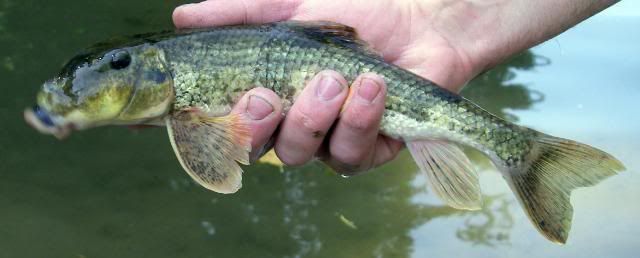
ideal habitat for these fish. We found a lot of young of year ones near the riffles. A few larger ones were located at the tail of the riffles.
Black Redhorse (Moxostoma duquesnei)

- only found a few here. This was the largest too. Our sample here didnt include any of the deeper holes that were adjacent to the site. If we were to sample those, I bet we wouldve found adults.
Golden Redhorse (Moxostoma erythrurum) we did find adults of these though in the shallow pools.
Shorthead Redhorse (Moxostoma macrolepidotum) found a few large ones. We could see them as we were motoring through the pools to get to the upstream point of our sampling site. What we found later is that some of those red tailed redhorse were also River Redhorse.
River Redhorse (Moxostoma carinatum)
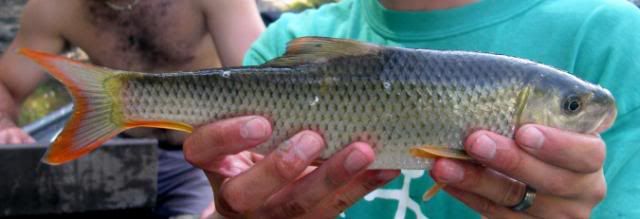
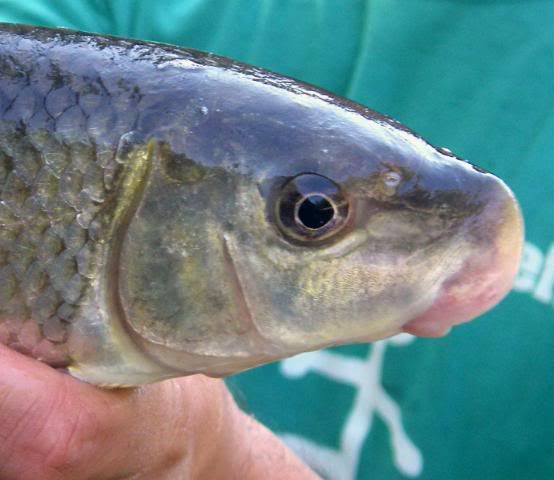
only found one of these in the pools. However in the clear water, this fish had a tail that was quite striking. Im not sure if thats a function of being in the clear water or perhaps the diet of the fish. Noticeable missing from this sample was any Silver Redhorse. They seem to be more of a big river fish. Although it could have been the case that if we sampled the deeper pools, we would have found some. Also, we found very few young of year redhorse. This is probably because they spend their first year in smaller tributaries to the rivers that we were sampling.
Channel Catfish (Ictalurus punctatus) only found a few, but the ones we did find were pretty large. As we were motoring up, we could see that every rock structure in the pools had large Channel Catfish resting in and around them. A person would be able to sight fish for large Channel Catfish here. Clear shallow pools with large Channel Catfish, sounds like fun.
Flathead Catfish (Pylodictus olivaris) only one smaller one. Was found in the same fashion as the Channel Catfish.
Blackstripe Topminnow (Fundulus notatus) tons were found in the minimal amount of vegetation that was there.
Brook Silverside (Labidesthes sicculus) only a few
Rock Bass (Ambloplites rupestris) these fish were everywhere in the pools. Anywhere there was a rock structure, there were 10 Rock Bass sure to come out of it.
Northern Largemouth Bass (Micropterus salmoides salmoides) only found a few small ones, I was watching them chase Bluntnose Minnows around from my canoe.
Northern Smallmouth Bass (Micropterus dolomieu dolomieu)
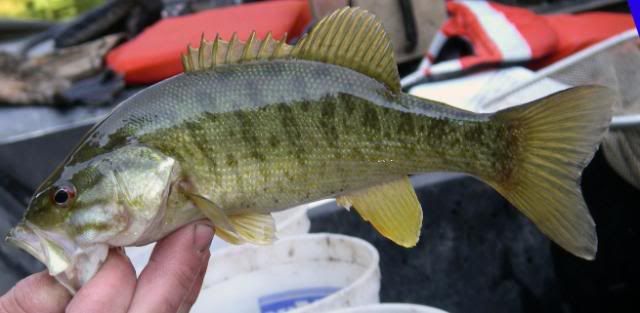
- didnt find any large ones, but they were still healthy looking.
Warmouth (Lepomis gulosus)
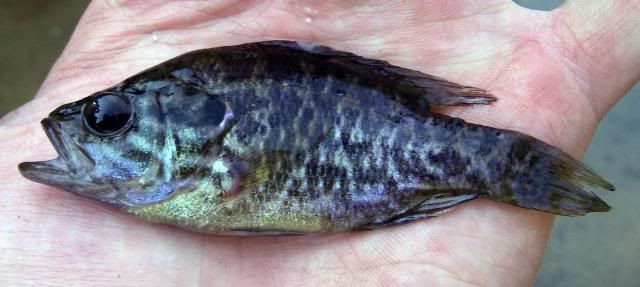
- only found one small one. It seemed out of place too. I normally dont associate Warmouth with small, clear rivers that are loaded with Stonerollers.
Bluegill Sunfish (Lepomis macrochirus macrochirus)
Green Sunfish (Lepomis cyanellus) the most abundant sunfish here.
Orangespotted Sunfish (Lepomis humilis) only one. Also seemed a little out of place here. Seems that the Orangespotted Sunfish in Illinois is in greater numbers in rivers that get a heavier silt load than this one.
Northern Longear Sunfish (Lepomis megalotis peltastes) also abundant.
Northern Logperch (Percina caprodes semifasciata)

- a few really healthy looking ones here.
Slenderhead Darter (Percina phoxocephala) a few were found along the vegetation that was in the riffle areas.
Blackside Darter (Percina maculata)
Johnny Darter (Etheostoma nigrum)
Banded Dater (Etheostoma zonale) these were packed densely into the riffle areas here. We probably got over 100 per 5 square meter. I know that darters can occur in higher densities than this, but for our study, this was the highest density we'd seen so far.
Freshwater Drum (Aplodinotus grunniens) found fish between 1-2lbs. schooling with Central Quillback. The water was clear enough so that someone could sight fish for Drum here too. They did spook easily though.
Notes: There was pretty good minnow diversity here. The Largescale Stonerollers were very abundant and it was interesting to find them here. We sampled rivers adjacent to this river and didnt find any in those rivers. When I was walking along the bank, I also caught a few Cricket Frogs
#58
 Guest_NateTessler13_*
Guest_NateTessler13_*
Posted 19 February 2008 - 12:12 PM
Location: Vermillion River (Illinois River tributary) northwest of Streator, IL. At E. 15th Rd. Near SR 23.
Water Level: At normal water levels for this time of year. Average depth was about 1.2m and rather uniform.
Water Quality: The water was stained, but there wasnt a lot of siltation on the sand flats.
Water Temp.: 23*C
Substrate: Mostly sand. Limestone bedrock made up the bottom of the pools. The flow was pretty slow throughout most of the stretch that we sampled, but there was a small sand riffle that we looked for Sand Darters at, but didnt find any. Structure was at a minimum. There were a few downed trees, but otherwise the area was one large sand flat.
Collected:
Common Carp (Cyprinus carpio) near the one or two fallen trees, there were small groups of large carp.
Bluntnose Minnow (Pimephales notatus) only one. This area didnt have much suitable habitat for different minnow species.
Highfin Carpsucker (Carpiodes velifer)
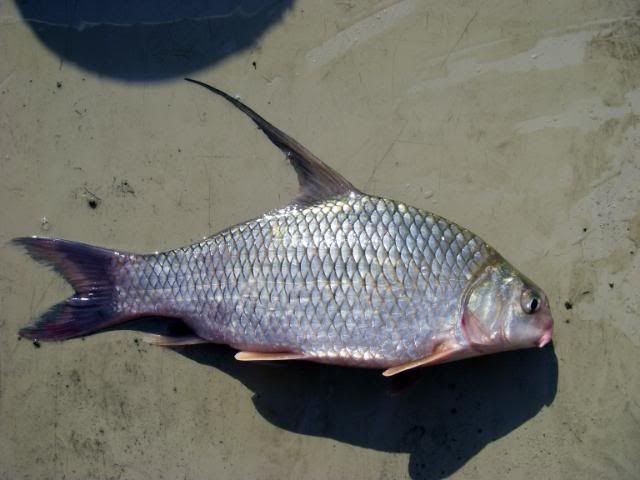
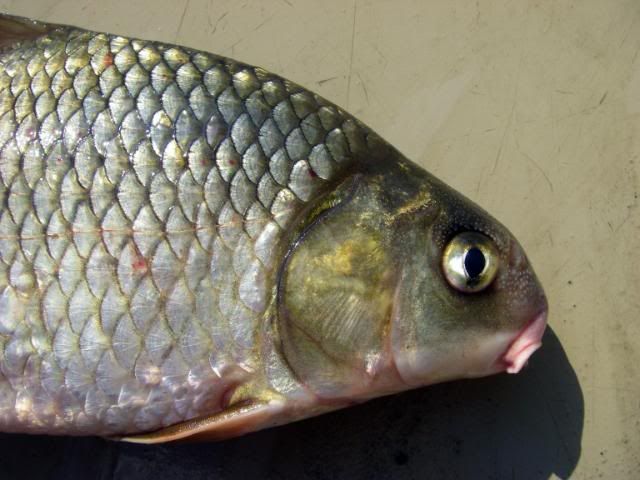
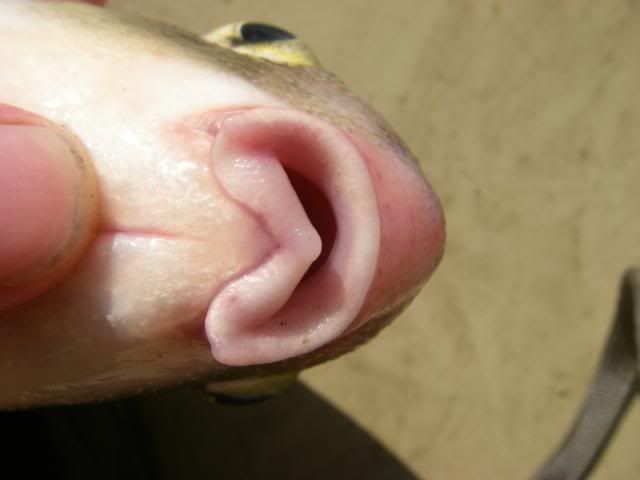
this was my first time seeing this species of sucker that is an inhabitant of larger rivers. The dorsal fin was very exaggerated, and it was obvious when I first saw them that they were not Quillback. Brian took time out here to really get good photos of these fish. We got a few nice sized adults here. The 1st picture gives you an idea of how exaggerated the dorsal fin is on these fish. The 2nd picture shows the head of a tuberculate male that was collected. Note the difference in the color of the head also between the female shown in the 1st picture and the male shown in the 2nd. The 3rd picture show the tell-tale nipple on the bottom lip of these fish. This will help distinguish this fish from a Quillback (as Quillback lack this feature).
Central Quillback (Carpiodes cyprinus hinei) found alongside the Highfin Carpsucker directly in the middle of the river channel.
Black Redhorse (Moxostoma duquesnei) only one smaller one.
Golden Redhorse (Moxostoma erythrurum) lots of very large ones. Seems like when the water clarity decreases, Golden Redhorse replace Black Redhorse as the dominant Redhorse species.
Silver Redhorse (Moxostoma anisurum) a few, but they definitely seem to be a fish associated with larger rivers.
Shorthead Redhorse (Moxostoma macrolepidotum) only one.
Northern Hogsucker (Hypentelium nigricans) not many. There wasnt prime Hogsucker habitat here though. In other areas near the mouth of this river, there are high gradient stretches where the Hogsucker probably flourishes.
Channel Catfish (Ictalurus punctatus) a few large ones were near the few trees that were down in the water.
Yellow Bullhead (Ameiurus natalis)
Blackstripe Topminnow (Fundulus notatus)
Black Crappie (Pomoxis nigromaculatus) only a few small ones.
Northern Largemouth Bass (Micropterus salmoides salmoides)
Northern Smallmouth Bass (Micropterus dolomieu dolomieu) only a few small Largemouth and Smallmouth Bass here. Mainly due to lack of habitat (structure to ambush from).
Bluegill Sunfish (Lepomis macrochirus macrochirus)
Green Sunfish (Lepomis cyanellus)
Redear Sunfish (Lepomis microlophus)

found a few small ones here. Not sure if this is in their native range. The picture shows the red on the edge of the opercular flap.
Orangespotted Sunfish (Lepomis humilis)
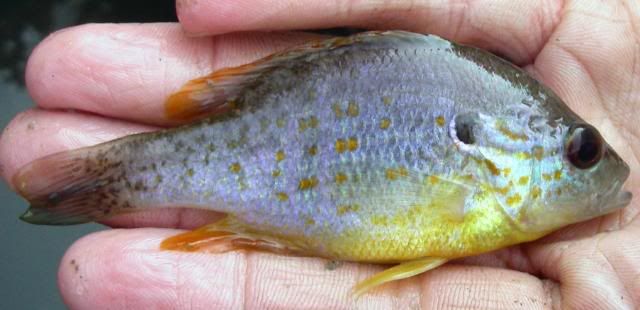
only a few. These were along the shoreline where there was minimum submerged tree roots. Pictured is a nice sized adult male.
Central Longear Sunfish (Lepomis megalotis megalotis) definitely looked like full-blown Centrals here, as opposed to Northerns. Im not sure why we didnt photograph any here. It would have been nice so that I could have had a comparison between these fish and the Northerns that are common in the rivers that surround this one.
Hybrid Sunfish (Lepomis hybrid)
Slenderhead Darter (Percina phoxocephala) found a few in the faster flowing sandy areas. The same areas we were looking for Sand Darters (but came up empty handed).
Blackside Darter (Percina maculata) found a couple in the slack water near the shoreline.
Rainbow Darter (Etheostoma caeruleum) not sure where this one came from. There was practically no suitable habitat for these fish.
Freshwater Drum (Aplodinotus grunniens) a few large ones were in the main channel alongside the Quillback and Highfin Carpsucker.
Notes: This area of the river was low gradient and there wasnt much flow. The sandy bottom without much cover seemed to benefit sucker species, and without many predators they could be in this area because it is safe. We also found a small softshell turtle here
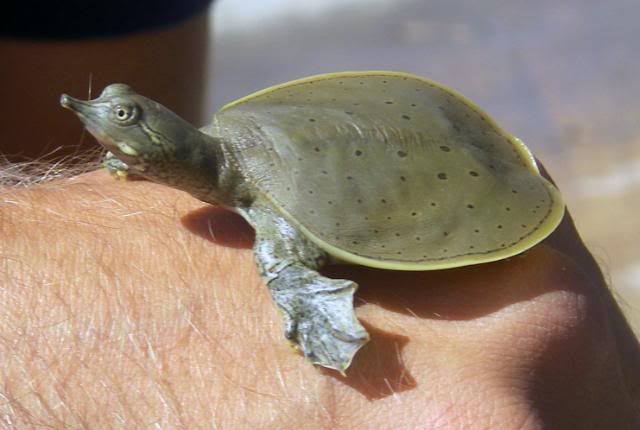
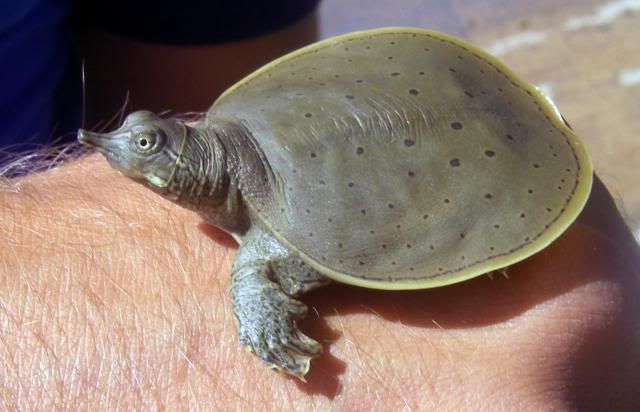
#59
 Guest_NateTessler13_*
Guest_NateTessler13_*
Posted 19 February 2008 - 12:16 PM
I was close! She's a false map turtle, Graptemys pseudogeographica. She could be the nominate race or the Mississippi map, G. p. kohnii (or an intergrade); I think both occur in that area, and I'd have to see the occipital area to be sure.
Thanks for that. You're pretty good with the herps. Could you help it out with the frog and turtle below too? I don't spend any time working on many things besides fish right now. I think I'm going to sign up for herpetology next semester at the university.
#60
 Guest_smbass_*
Guest_smbass_*
Posted 19 February 2008 - 01:30 PM
Reply to this topic
0 user(s) are reading this topic
0 members, 0 guests, 0 anonymous users




